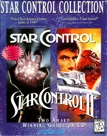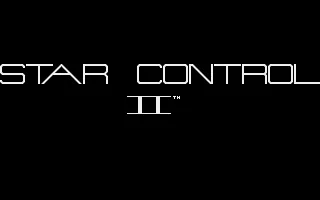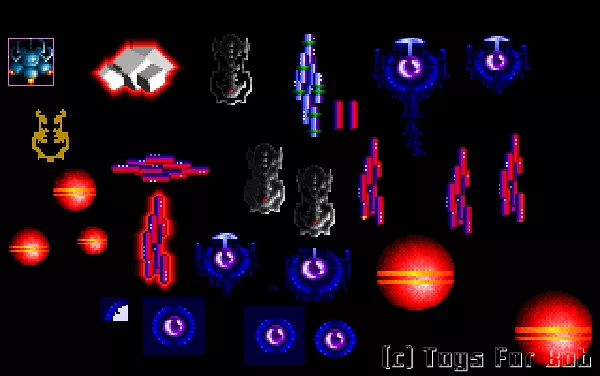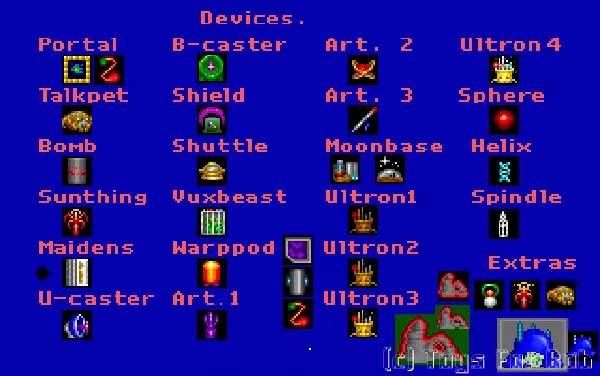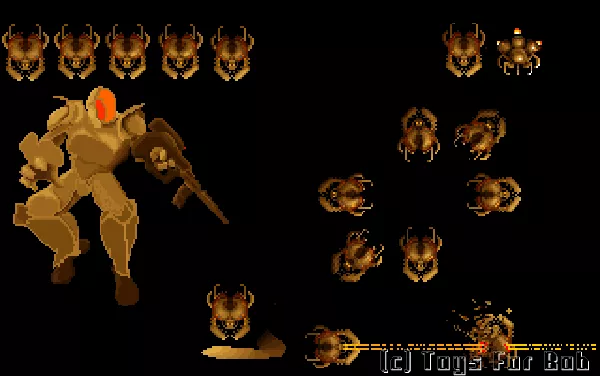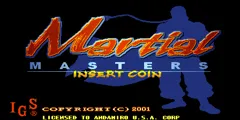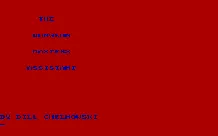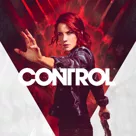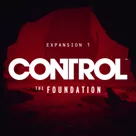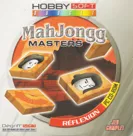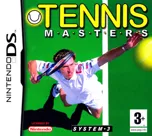Star Control II
Description official descriptions
Following an ongoing war with the alien Ur-Quan race, the Alliance has lost. The Ur-Quan armada systematically hunts down the alliance races and imprisons them onto their homeworlds. However, unknown to the Ur-Quan, a small research vessel had been lost during the war while sent to a distant star system looking for evidence of the ancient Precursor race. The survivors of this research team had come across the controls to a Starship factory and used it to build a Precursor supply vessel, one of the largest vessels in the galaxy.
Upon return, the captain of the ship discovers, to his dismay, that Earth has become one of Ur-Quan's slave planets. The surface of Earth is glowing red, devoid of life, and a few humans are locked in a starbase orbiting the planet. The captain contacts the starbase commander and finds out that the only way to defeat the Ur-Quan is to convince other races populating the galaxy to join them in their struggle.
Star Control II is a hybrid game based on exploration, space combat, and ship customization. Unlike its predecessor, it has a heavily plot-driven, quest-based structure reminiscent of role-playing or adventure games. The game's main focus is on exploring a vast galaxy consisting of numerous star systems and interacting with various alien species populating it. Each species has its own personal traits and would usually require the player to exploit conversation trees or perform different tasks to convince them to join. The main objective is to gather as many allies as possible, though only a few alliances are required to complete the game.
While in deep space, the starship can approach any star it comes across, and then the player can guide the ship around its system and land on its planets and their moons. Space is treated as two-dimensional and presented in a top-down view. There is also a starmap available which shows the entire galaxy and allows the player to set the ship on auto-pilot to any star.
Throughout space are different alien civilizations. These are represented on the starmap by a sphere of influence. Within the sphere, the aliens have a controlling presence and their ships will venture freely. Outside the sphere, encounters are rarer. Aliens can be dealt with diplomatically, through a series of dialog options, or engaged in combat.
Alongside the main plot objective, the player also configures and upgrades his fleet in a role-playing fashion. The main starship is the Precursor vessel and it can be used to travel between star systems, which uses up fuel. Raw materials are used as currency to make purchases in the starbase. It is possible to buy fuel, as well as improve the player-controlled fleet in various ways. These include purchasing smaller ships to accompany the main one on its travels and participate in combat; hiring crew members, which effectively act as the hit points of the ships; and upgrading the main ship with enhancements that improve its speed, maneuverability, and combat efficiency. Successfully completing a quest for an alien race may also result in their combat ships joining the fleet.
Raw materials are found on the surfaces of planets and moons throughout the galaxy. The player has to send a landing module to the planet and then guide it around the surface as it picks up materials found earlier with a scanner. Each planet is unique in the type of minerals and metals it is formed of. Some planets are plagued by natural dangers such as lightning storms, earthquakes, or lava, which can damage or destroy landing modules. Non-sentient lifeforms can also be found and stunned to obtain biological samples. Special installations, objects, and ruins can also be found on certain planets and explored.
Combat is action-based and utilizes the same engine as the first game, where action is controlled from a top view and influenced by the gravity of nearby planets. Each alien vessel has unique abilities, and the player can select any ship from his fleet to participate in battles, attempting to find the best combination against specific enemies. Combat can also be played as a standalone game (melee mode), separate from the main storyline. It can also be set on a cyborg mode within the main game, allowing the computer AI to take over the battles and calculate their results depending on the attributes of the ships.
Versions of the game titled The Ur-Quan Masters and Free Stars: The Ur-Quan Masters are freeware, open-source ports which combine DOS and 3DO content. These releases, alongside the source code, are handled by the original developers Paul Reiche III and Fred Ford, who own the copyright to all parts of the original games except the Star Control trademark.
Spellings
- Star Control 2 - Alternate spelling
- スター・コントロールII - Japanese spelling
Groups +
Screenshots
Promos
Credits (DOS version)
50 People (46 developers, 4 thanks) · View all
| Game Design & Fiction | |
| Game Program & Technology | |
| Additional Design | |
| Art & Animation | |
| Music | |
| Sound Effects | |
| [ full credits ] | |
Reviews
Critics
Average score: 81% (based on 27 ratings)
Players
Average score: 3.9 out of 5 (based on 239 ratings with 20 reviews)
I've never played a better game.
The Good
Star Control II had an epic plot of good against evil, in a space setting. Not only did the game have meaning, but alot of it was extermemly funny.
But the plot isn't it. The graphics may look bad to you now, but in 1992, those were top noch! They fit the theme of SCII really well. We can't forget the music! Music was done with MODs, and all of it fit the races really well. They barely had to talk to know what they were about. There's also the fighting portion, which is a seperate part of it, but also mixed in with the adventure part very well. The fighing was top down, where you have 2 ships destroy eachother. I spent many hours playing that against my friends...
The Bad
The Orz music! That's the most annoying sound in the world!
The Orz are pure evil people.
The Bottom Line
The game that is still praised 7 years after it's making.
DOS · by ZogGop + (5) · 1999
An immense, sprawling game of epic proportions; truly a classic!
The Good
For its time, Star Control II was state-of-the-art, combining the best elements of a real-time strategy, an RPG, an arcade game, and a space exploration game. The alien races each have their own unique style and personality, many of which are quite humorous. This game features a heroic struggle against oppresive overlords, which are not neccessarily evil, but rather obsessed with a millenia-old pact. Nevertheless, the game never gets preachy. A MUST-HAVE for any serious gamer.
The Bad
The graphics are somewhat dated (although not TOO MUCH), and the game generally runs far too fast on modern machines. Additionally, this title may not hold the interest of gamers who expect immediate results and constant, intense action. However, serious gamers, fans of real-time stragety games, and sci-fi fans will be amazed and delighted with the game, as it has aged EXCEPTIONALLY well.
The Bottom Line
A fantastic mix of sci-fi, action, comedy, drama, and strategy. If you have ever enjoyed a single sci-fi movie, book, or comic novel, you will LOVE this game.
DOS · by Lothian (11) · 2001
A very disappointing masterpiece
The Good
Star Control 2 came out at a time when presentation was still a big thing in computer games; today, graphics in most major-name games are pretty much photorealistic, and sound is movie-quality, so nobody thinks too much about it anymore. However, Star Control 2 did a lot in its time with both audio and graphics. The graphics in the game were top-notch for its time, and the much-loved soundtrack, consisting mostly of electronica/techno music, sounds great.
Star Control 2 is one of the most open-ended games I can remember playing. In many ways, it invites comparisons to the more recent Deus Ex, and for me, that's high praise indeed. Both games provide you with several ways to deal with situations: You can try and talk your way through various conversation trees, or you can simply blast your way through. In many cases, you can sneak your way through and hope you don't get caught. Also like Deus Ex, SC2 doesn't try to moralize your decisions too much... The point here is that this is a game you can play your way, and if you want to proceed by blasting an entire race of aliens into extinction instead of bartering with them, that's your choice. The game won't stand in your way, and mostly won't make you feel bad for choosing one approach over another.
In fact, in many ways, SC2 is actually more open-ended than Deus Ex, because DX required you to follow a fairly linear plot line; you could take some minor side deviations from that path, but ultimately, the game followed a set series of events. SC2, for the most part, doesn't require you to do things in any particular order, so again, you can do things however you see fit.
The universe of SC2 is HUGE. There are dozens and dozens of star systems outlined on the map that comes with the game. Each star system contains several stars, and each star is at the center of its own solar system, most of which have several orbiting planets that you can go to. The game also includes a lot of dialog; a small text file update that installs with the game mentions "enough player-alien dialog to fill a novel", and I don't think that's too much of an exaggeration. In fact, the story behind Star Control 2 is so well-developed that I'm a little surprised we haven't seen movie conversions of it. This game is worth it, and if properly done, it has enough depth to hold its own against the Star Wars and Lord Of The Rings franchises. This is an epic story of a galaxy-wide war between several alien races, each of which has its own motivations and culture.
The Bad
I'm amazed by the number of reviews here on MobyGames that claim they can't come up with anything negative to say about this game. For all of you fans: I'm about to list several things that I think ruin this game, so if you think criticism of SC2 is blasphemy, I'm sorry, but this game is far from perfect.
The main problem with SC2 is that the gameplay isn't very well balanced. Near the very beginning of the game, you're asked by a starbase commander to go and collect some minerals from a nearby planet so that the starbase can convert them into energy to power the station. The process of collecting these minerals involves a little mini-game in which you control a planetary lander that simply drives around the surface of the planet, picking up dots which represent caches of valuable elements. "What a cute little mini-game," I thought when I first saw this procedure; "I wonder what other mini-games I'll see as I continue playing." Upon bringing the minerals back to the starbase commander, however, you soon learn that he expects you to get much more. The first delivery of minerals was just an emergency supply, to help bring the station's life-support systems back online. After that first mining expedition, the commander explains that you'll need to get more raw materials in order to get anything from the station. And most of what you'll need in this game, you get from that station: You can buy additional ships, extra crew to populate your ships, and fuel to propel your ships to the farthest reaches of the galaxy. Here comes the game's first problem: The focus on collecting these raw materials.
The process of getting minerals, as I've already mentioned, is a mini-game of driving a lander around. This process is somewhat amusing the first time you do it, but you'll discover that you're expected to do it again. And again. And again. Over and over and over, you'll need to go to some planet that you haven't already stripped bare, send down a planetary lander, and steer the lander around until you've finished picking up all the minerals. Then you go to another planet and do it again.
All of this might not be so bad if the game introduced new and interesting ways of making the mining process different; perhaps little puzzles or something that you had to solve. I usually discourage puzzles just for puzzles' sake (i.e. puzzles which are clearly shoehorned into a game and don't have any real relevance to the plot), but even those kinds of puzzles would be preferable to the complete lack of variety in the mining process. The only thing that counts for "variety" in the mining is the lightning strikes and earthquakes on the planetary surfaces; however, these phenomena happen too quickly for you to be able to react to them most of the time, so they end up creating more of a "random death" factor than any kind of additional gameplay element. On every planet, the procedure is the same. This very quickly starts to feel like work. But you have to do it, because your starship needs fuel, and you can't get fuel without raw materials.
Consider the example of another much more recent game: Grand Theft Auto: San Andreas. Now, when GTA:SA was being developed, people worried about the food and exercise aspect of the game. Unlike previous GTA games, you have to make your character eat and exercise every now and then so he doesn't get out of shape. This sounds like a dumb little distraction from the real focus of the game, but in actuality, you don't have to do it very often, so it doesn't get in the way too much. Annoying, perhaps, but it's such a small part of the game that it doesn't ruin the whole game.
Star Control 2 should have taken a similar approach. If the designers wanted to make a game in which you had to go mining, okay, maybe that could have been a little side chore. But as it is, it's actually the main focus of the game.
The other big problem with SC2 is its gameworld. People praise this game for having such a huge space to explore, with so many solar systems and planets. You could spend a long, long time exploring every nook and cranny of the Star Control 2 universe. But if you try to do so, you'll quickly discover that most of those planets don't have anything interesting on them. Yes, there are a lot of planets, but when you visit each one, you won't find much there. Nobody to talk to, no places to explore, no puzzles to solve; about the only thing that most planets have is minerals, and so the only thing you can do with them is send down your lander and play the stupid little mining game. I initially exulted at SC2's big world, thinking of all the places I would see and explore. But exploration gets old really fast, because all the planets look the same after a while, and there's nothing on most of them.
In fact, sadly, the gameplay mechanics actually discourage exploration, because going anywhere in the galaxy requires fuel, and again, the only way to get fuel is through mining. So you end up with a catch-22 situation: To go to other planets requires fuel, and once you get to those planets, there's nothing to do but mine more raw materials, which you use to fly back to base so you can buy more fuel. Seriously, what's the point of that?
Of course, if you play the game well and use your fuel efficiently, you can do more than break even; you can come up with a net surplus of raw materials, but the other things you can buy with raw materials don't make the game much better. You can buy additional fuel tanks to store more fuel (which becomes necessary to reach planets farther away from your starbase), extra jets to make your ship fly and turn faster (which is useful in combat, and also helps make interstellar travel less boring by making your ship go faster), and you can buy additional ships (which serve no purpose except in combat). These things are useful, but they still don't make the mining process any more interesting.
Now, to be fair, there is another way you can get raw materials: Combat. When you defeat an enemy ship, you scavenge raw materials off that ship when the battle is over. If you prefer fighting to trolling the ground for minerals, you may prefer to go this way, but you'll need to do an awful lot of fighting to get enough raw materials to buy the fuel you need. Yes, it's an alternative, but constantly fighting for your livelihood still feels more like work than a game. Also, whenever your ship gets hit in combat, crew members on board die, and crew members, like fuel, are expensive. (Oddly, you can "buy" crew at the starbase in exchange for raw materials too; apparently the engineers on the base have figured out how to manufacture humans from their component elements.)
All of these factors combine to make Star Control 2 less of a game. I've come back to this game time and time again, feeling like I'm missing something, and every time, the negatives I've cited here keep me from having much fun.
To be sure, Star Control 2 is a masterpiece. Clearly a lot of work has lovingly been put into the story and atmosphere; what a shame, then, that the actual gameplay mechanics seem to have been glanced over. Indeed, this game probably would be better as a movie, because if you remove the monotony and keep the plot, you'd have a winner. Sadly, as it is, if you want a game in which you drive a little vehicle around picking up minerals for an hour, then go to another place and do it all over again, this is the game for you.
The Bottom Line
A brilliant story in a vast universe... But not much of a game.
DOS · by Adam Luoranen (92) · 2005
Discussion
| Subject | By | Date |
|---|---|---|
| Classic Game Postmortem: Star Control (I and II) | vileyn0id_8088 (21040) | Jun 13, 2015 |
| Does anyone own the CD-ROM release? | Terok Nor (41952) | Aug 14, 2009 |
| Solution to the lack of an "objectives" screen | Matt Neuteboom (976) | Nov 4, 2008 |
| This game is how I found out about mobygames | Lumpi (189) | Nov 3, 2008 |
| PC speaker support. | Virgil (8563) | Jun 17, 2007 |
Trivia
Cancelled add-on
Fred Ford and Paul Reiche III confirm to have worked for four months on a add-on pack which was never completed due to Accolade's lack of interest.
Development
Ford and Reiche disappeared to Alaska and worked on this game for an additional six months without pay. Only that during this time, the game grew from two to nine megabytes, thousands of dialogue lines were added, the digital music appeared and a complete galaxy with hundreds of stars and thousands of planets made its way into the game.
Files
- The .SHP files are interchangeable meaning that you can rename them to swap them around. This can be used to change the ship you start with in the full game.
- All the music and victory ditties in the game are in .MOD format and can be extracted by a utility called a Mod Ripper.
Freeware release
The game was released free to the public in 2002 by its original designers. Everything except the name Star Control (still owned by the publisher) is now freeware. However, it not the true open source of the DOS version. When Toys for Bob set out to release their code they found that a lot of it had simply been lost. However what was available was all of the source code for the 3DO version of the game. So what happened is that all of that code was ported to the open source project and then several portions of it that were "different from the PC version" (mostly menus and interface issues) were then later re-coded. Incidentally many things in the game can be set to "3DO mode" or "PC mode" via command line parameters explained in the readme.
Influences
The game is suspiciously similar to the Starflight series of games. A direct comparison can be made of such gameplay ideas as the gathering of raw materials, the exploration of space, the coordinate map, even the alien diplomacy/interaction that makes this game famous. The first Starflight was able to do this years before Star Control.
Mods
A large-scale open-source project has been launched with the aim of updating Star Control II to run on pretty much all modern computers and operating systems, along with better graphics and other improvements. The homepage for the project is at http://sc2.sourceforge.net/.
Music
Musician Aaron Grier:
There was actually a contest for writing the music fo star control II advertised on comp.sys.amiga.audio. Nobody knew what game it was for, and Paul had asked a friend to troll usenet for entries. I submitted "Fuchia Fantasy" not even expecting it to be taken seriously, and ended up winning second place in the contest, (Riku being the big winner, of course,) which entitled me to $50 and a copy of the game when it came out. It took about a year after I was notified I had won for the paperwork and check to come, (along with an amusing apology,) and another six months or so after that for the game to actually get to me, (along with another amusing apology.) Both letters are still sitting somewhere in a box in my father's basement in Denver, and one of these days I'll have to dig through the files and post scans somewhere.
Dan and Riku (who met through SC2) got together and formed the 8-bit collective, which turned into KLF, which begat KFMF, and is still going strong.
Rainbow planets
If you discover the location of all the rainbow planets, they form an arrow pointing towards the galactic core (top right corner). The worlds were created by the Precursors and the arrow hints at where they disappeared to. The original purpose of the arrow was, according to the creators themselves, to point toward a single planet where the player would have an interactive conversation with the two creators. This was never completed.
References
- Several of the new races in the game (such as the Orz) were named from alien words on the copy protection wheel for the first game. "Melnorme" is a rather obvious corruption of the singer Mel Torme's name.
- During the game, when talking to Starbase Commander Hayes, if the player chooses "The United Federation of Worlds!" when being prompted to name the new alliance, Hayes will say: "That has a familiar ring to it... nonetheless, we will make it so - The United Federation of Worlds!" This is an obvious reference to the United Federation of Planets from Star Trek.
Stars and planets
Most of the Stars are named after real Stars, even though the distances and postions are mostly wrong. Their positions according to the starmap are actually hyperspace coordinates and not realspace coordinates. If you notice a little footnote in the bottom, it explains about this pretty clear.
The planet information is based on true astronomic readings and some of the parameters are calculated when you enter the planet. The planet surfaces are also calculated according to some of these parameters. When entering a star system, the planets are raytraced, which is the cause of the noticeable delay (on a 286 anyway) when entering a star system.
Awards
- Computer Gaming World
- October 1993 (Issue #111) – Adventure Game of the Year (together with Eric the Unready)
- November 1996 (15th anniversary issue) - #29 in the “150 Best Games of All Time” list
- November 1996 (15th anniversary issue) – #9 Most Rewarding Ending of All Time
- September 2006 (Issue #266) – Introduced into the Hall of Fame
- GameSpy
- 2001 – #26 Top Game of All Time
- VideoGames
- March 1995 - Best Adventure Game in 1994
Information also contributed by Aaron Grier, Aj Hege, Arvin Chandra, Big John WV, Fafnir, Luka Milutinovic, PCGamer77, Tiago Santos, Tomer Gabel, Toni Maki, Vance, WildKard and WizardX
Analytics
Upgrade to MobyPro to view research rankings!
Related Sites +
-
Ganymede
Homepage of (among other things) the Pages of Now & Forever's official Star Control II walkthrough, a comprehensive guide to the game and its mysteries. -
Infogramme/Accolade Tech Support
Has a link to the latest (last :) Star Control 2 patch. -
More Control!
Webcomic Bob the Angry Flower spends an episode arbitrarily experiencing the world of SC2. -
QuasiSpace
Another quality SC site. -
Star Control 2 featured on PC Gamer!
This page has a screenshot from SC2 along with a featured description of MobyGames itself, scanned from the July 2000 issue of PC Gamer. -
Star Control II SuperMelee Extended Reference
Covers the SuperMelee module of Star Control II for the 3DO. Most of the information also applies to the PC game. -
Star Control Series Index
I've set up a section on DMOZ all about the Star Control series of games. -
The Pages of Now & Forever
A -huge- Star Control II fan site with comprehensive information, humour and everything a fan could possibly want (including links to other fan sites) has been set up by Chad Darrenbacker. (Contributed by Tomer Gabel) -
The Star Control Webring
A now frequently updated webring including most (if not all) of the major Star Control-related web sites. -
The Ur-Quan Masters Project
A free, open-source, cross-platform port of Star Control II for Windows, MacOS X, Linux, all BSD, BeOS, and other SDL-supported platforms. -
Time Warp
One of the more promising Star Control clones which emphasizes multiplayer (network, modem etc.) melee play.
Identifiers +
Contribute
Are you familiar with this game? Help document and preserve this entry in video game history! If your contribution is approved, you will earn points and be credited as a contributor.
Contributors to this Entry
Game added by Tomer Gabel.
GP2X added by Trypticon. 3DO added by Shoddyan. Android added by Sciere. Windows, Linux added by The cranky hermit. Macintosh added by Multimedia Mike.
Additional contributors: Trixter, ZogGop +, Ledmeister, Salim Fadhley, Shoddyan, Pseudo_Intellectual, Halleck, formercontrib, RealityHacker, Patrick Bregger, Omer Mor, Plok, Kayburt.
Game added August 3, 1999. Last modified March 2, 2024.

